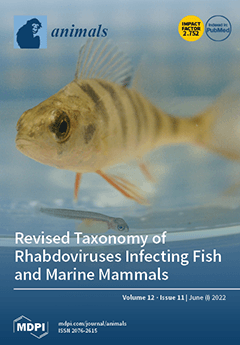This study evaluates the in vitro probiotic characteristics of
P. konkukensis sp. nov. SK-3146, which was isolated from animal feed, and its dietary effects on growth performance, intestinal characteristics, intestinal microbiota, and meat quality in broilers. In vitro experiments revealed that
P. konkukensis
[...] Read more.
This study evaluates the in vitro probiotic characteristics of
P. konkukensis sp. nov. SK-3146, which was isolated from animal feed, and its dietary effects on growth performance, intestinal characteristics, intestinal microbiota, and meat quality in broilers. In vitro experiments revealed that
P. konkukensis was non-hemolytic with variable antibiotic susceptibility, and acid as well as bile tolerance. To assess the effect of
P. konkukensis on broilers, a total of four hundred eighty 1-day-old Ross 308 broiler chicks were allocated to 3 treatment groups with 4 replicates of 40 birds each; the negative control group was fed a basal diet without any feed additives (NC), the positive control group was fed a basal diet containing 0.01% enramycin (PC), and the experimental group was fed a basal diet containing
P. konkukensis bacterial culture (PK) at 10
4 CFU/g of the diet based on bacterial count. The experiment lasted for 35 days. Results indicated that there were no significant differences in any growth performance parameters among the dietary treatments (
p > 0.05). In addition, the inclusion of
P. konkukensis in the broilers’ diet did not affect meat cooking loss, color, and pH but increased the relative weight of breast meat (
p < 0.05). The PK group showed heavier intestinal weight and shorter intestinal length than the NC group (
p < 0.05). The ratio of the intestinal weight to length of jejunum was the highest in the PK group (
p < 0.05). The PK group showed increased counts of
Streptococcus thermophilus (
p < 0.05) with no adverse effects of
P. konkukensis on other intestinal microbiota in the jejunum. This study implies that
P. konkukensis might have the potential to be applied as a probiotic feed additive in poultry.
Full article






